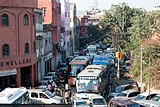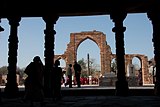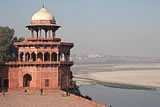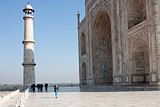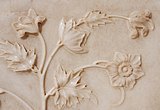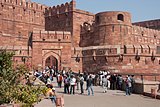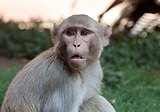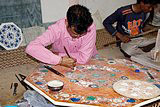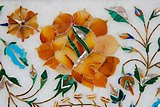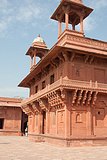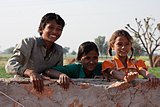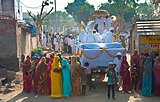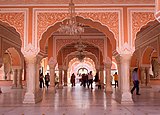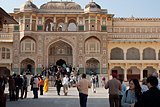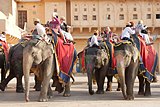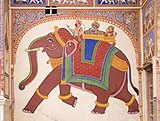
India and the Golden Triangle
India. Well, neither of us had ever been there and it had never really featured on our list of desired locations, despite friends telling us how wonderful it was and how it would change our lives. Over recent years, Suzy has developed an obsession with travel brochures and of late, shelf space in our home has filled up with glossy magazines promoting travel to all parts of the world, including of course, India. Some years ago I casually mentioned that it would be quite a trip to travel the length of India by railway, danger words, and small relays must have clicked home in her head for she never quite forgot my casual comments and every time the Taj Mahal or a Mughul fort appeared in a brochure, she would say "we really aught to go, you know" and I would grunt in a sort of agreement. Anyway, more recently she spotted an advert in the Sunday Times I think, for a 10 day trip with Riviera Travel, Suzy was soon checking out its credentials on the internet, and for better or for worse we were suddenly shelling out money for a trip to the sub-continent of India.
chris and sue jackson e-mail
February 8th. After a 9 hour flight from Heathrow we arrived in New Delhi at about 11:20 local time, and our group of 38 were soon established in the Splendid Taj Palace Hotel, ***** opulence that Suzy and I weren't exactly used to. Still, we coped somehow and despite its luxury it remained fairly informal and dressing for dinner would have looked out of place amongst other diners. The weather was fine and pleasant and apart from the last couple of days when we had some rain, remained in the low/middle twenties throughout the holiday.
No rest for the wicked though, and within an hour we were on our coach heading through the chaos that is Delhi's traffic to visit India's largest mosque Jami Masjid in Old Delhi. We thought that New Delhi traffic was pretty serious with cars, lorries, tuk-tuks and motorcycles all jostling for position, often three lanes cutting and thrusting on both sides, but it paled into insignificance when compared with that of Old Delhi which was more like a grid locked car park. Left, Suzy dreaming about tigers, 2, within the courtyard of Jami Masjid, where we were obliged to remove our shoes and Suzy was enveloped in a sort of bright blue poncho.
Picture 3 shows a typical street scene in Old Delhi, that's our bus wedged in the traffic. How our driver ever emerged with his brand new Mercedes bus unscratched is a mystery. The old town was incredible and amongst all the litter and cows was a multitude of tiny crowded shops selling everything from chewing tobacco to a spare off-side shocker for a tuk-tuk, the ubiquitous motorised rickshaw.
Picture 4, discussion or despondency on the steps of the mosque.
After Old Delhi we were taken to the relative peace of Raj Ghat, an area of parkland containing a memorial to Mahatma Gandhi.None of us felt we could cope with the splendid hotel buffet so after a pizza the size of a lorry wheel I/we retired to a well earned sleep.
February 9th. An early call at 6.30, bags outside the door for 7.00, breakfast and in the coach by 8.00 it was all go. Today we were to visit Humayun's Tomb. Humayun, the eldest son of Babur, succeeded his father and became the second emperor of the Mughal Empire. He ruled India for nearly a decade but was ousted by Sher Shah Suri, the Afghan ruler. Humayun took refuge at the court of the Safavid ruler, Shah of Persia, who helped in regain Delhi in 1555 AD. Unfortunately, he was not able to rule for a long time and met with his untimely death after he fell from the stairs of the Sher Mandal library. Or was he pushed? So now you know, but check out the link for more detail.
The Qutub complex contained some impressive ruins, see picture 1, but our crowded itinerary only allowed us 30 minutes wandering, less than that after our guide Manni had explained some of the complex history of the ruins. You may have w ondered whether a minaret was in fact a small minar, and you would be correct to wonder. Picture 2 shows the largest minar in the world, the Qutub Minar with a height of 72.5m, the banner also shows some detail from it.
ondered whether a minaret was in fact a small minar, and you would be correct to wonder. Picture 2 shows the largest minar in the world, the Qutub Minar with a height of 72.5m, the banner also shows some detail from it.
The Qutub Minar and mosque is located in Delhi and it is the world's tallest brick minaret. Construction commenced by Qutb-ud-din Aibak who won Delhi from the Prithviraj under Muhammad of Ghor as his commander in chief, and finished by Iltutmish. The Qutub Minar is notable for being one of the earliest and most prominent examples of Indo-Islamic architecture. It is surrounded by several other ancient and medieval structures and ruins, collectively known as the Qutub complex. It's construction was started in 1192 and still never ceases to amaze.
From the Qutub complex we made a long bus journey to Agra, first through crowded and litter strewn suburbs, jammed with cars and tuk-tuks, full of small shops, outdoor stalls, cows, goats and the occasional elephant into a region of wide fields of wheat and other cereals. After several hours we arrived at the city of Agra and the wonderfully peaceful Trident hotel for the next stage of our trip.
February 10th. Once again it's up at 6:30, but this time we have to be outside at 8.00 and loaded onto a rickshaw ready for our trip to visit the Taj Mahal. Plan A was to visit it early morning but early morning fogs at this time of year dictated a later start. Fine by us. Cars are not allowed to approach the Taj Mahal due to damage to the marble by pollution. Picture 1, en masse by rickshaw provided that the cow gets out of the way. It was all very busy, made busier by persistent and sometimes infuriating attention of street hawkers who were insistent that we needed postcards, fridge magnets, strings of beads and scented wooden elephants. Maybe.
We'd all seen pictures of the Taj Mahal but nothing really prepared us for its etherial beauty. Gleaming white marble is further emphasized by the more traditionally coloured red sandstone mosque and visitors residences that flank the Taj. The authorities were all very aware of the erosion and damage that the millions of visitors are unintentionally causing and we were all obliged to wear special overshoes.
The Taj Mahal was built by a Muslim Emperor Shah Jahan who died 1666 in the memory of his favourite wife and queen Mumtaz Mahal at Agra, India. It has been described as an elegy in marble or an expression of a dream. Taj Mahal (meaning Crown Palace) is a Mausoleum that houses the grave of queen Mumtaz Mahal at the lower chamber. The grave of Shah Jahan was added to it later. The queen’s real name was Arjumand Banu. In the tradition of the Mughals, important ladies of the royal family were given another name at their marriage or at some other significant event in their lives, and that new name was commonly used by the public. Shah Jahan's real name was Shahab-ud-din, and he was known as Prince Khurram before ascending to the throne in 1628.
Taj Mahal was constructed over a period of twenty-two years, employing twenty thousand workers. It was completed in 1648 C.E. at a cost of 32 Million Rupees. The construction documents show that its master architect was Ustad ‘Isa, the renowned Islamic architect of his time. The documents contain names of those employed and the inventory of construction materials and their origin. Expert craftsmen from Delhi, Qannauj, Lahore, and Multan were employed. In addition, many renowned Muslim craftsmen from Baghdad, Shiraz and Bukhara worked on many specialized tasks.
Picture 2, the classic picture of the Taj Mahal reflected in the ornamental lake, picture 3, looking out across the river Yamuna towards Agra from the edge of the platform on which the Taj Mahal is built. Picture 4, Suzy emerging from the morning shadow on the south side of the Taj. The minarets all lean slightly outwards, some say it's so that in case of an earthquake they will fall outwards, other theories suggest it is to counteract perspective when looking up. Or both.
Pictures 5 and 6 just a small sample of the decorations on the Taj Mahal.
We pottered around the adjacent buildings which were fairly stunning in themselves and I got shouted at for not removing my shoes in the mosque. Quite right too.
But the day was not yet done, one can't visit Agra without calling in at the Agra Fort. This magnificent UNESCO World Heritage Site is more a town than a fort, though the battlements and the spiked, elephant proof main gate tell another story.
Agra Fort is about 2.5 km northwest of its more famous sister monument, the Taj Mahal. The fort can be more accurately described as a walled city.
It is the most important fort in India. The great Mugals, Humayun, Akbar, Jehenqir, Shah Jahan and Auranqzeb lived here, and the country was governed from here. It contained the largest state treasury and mint. It was visited by foreign ambassadors, travellers and dignitaries.
It was originally a brick fort,held by the sikarwar, it was mentioned for the first time in 1080 AD when a Ghanznavide force captured it. Sikandar Lodi(1487–1517) was the first Sultan of Delhi who shifted to Agra and lived in the fort. He governed the country from here and Agra assumed the importance of the second capital. He died in the fort in 1517 and his son Ibrahim Lodi held it for nine years until he was defeated and killed at Panipatin 1526. Several palaces, wells and a mosque were built by him in the fort during his period. Check out the link for more information.
Picture 1, ladies carrying grass, 2, the outer walls of the Agra Fort, interestingly, the approach path to the main gate was curved and the gate studded with iron spikes all to prevent elephants of the attacking army getting a run at it. There was miles of it, picture 3 shows a typical bit or ornate palace work withing the walls. Picture 4, from the battlements it was possible to see the Taj Mahal floating on a sea of haze above the River Yamuna.
5, picture, monkey at Agra Fort.
Before returning to our hotel we were taken to some local workshops where artisans were making some remarkable inlaid tables and plates. All the inlay was on local marble and semi precious materials such as turquoise, jasper, lapis lazuli and malachite we painstakingly cut out into the shape of flowers and petals to be precisely inlaid and cemented into the sheets of marble. Picture 1 the marble is coated with a red watercolour so that the inlays design can be more easily seen by the designer. Picture 2 a small part of a large design, jasper, turquoise and malachite. These techniques are the same as those used for the decorations on the Taj Mahal and the recipe for the cements which still holds the semi precious stones in place remains a secret.
Beautiful stuff but very expensive and where would we put it if we got it home? It would probably end up in the loft.
February 11th. Next day we visited the ruined city of Fatehpur Sikri built in 1571 as Emperor Akbar's imperial capital. Fatehpur Sikri (the City of Victory) was the capital of the Mughal Empire for only some 10 years. The complex of monuments and temples, all in a uniform architectural style, includes one of the largest mosques in India, the Jama Masjid. Fatehpur Sikri bears exceptional testimony to the Mughal civilization at the end of the 16th century. It offers a unique example of architectural ensembles of very high quality constructed between 1571 and 1585. Its form and layout strongly influenced the evolution of Indian town planning, notably at Shahjahanabad (Old Delhi). Check out the link for more detailed information.
Picture 1, a typical piece of the beautiful architecture at Fatehpur Sikri, 2, Indian ladies in traditional dress.
After lunch, we were transported to the local railway station for a taste of Indian railways. It was nothing like as busy as some of the film footage I have seen suggested though there was always considerably excitement when a train stopped and people would flood onto the line. The luggage went by bus and didn't arrive at the hotel until almost midnight as the road was blocked by an overturned lorry.
Picture 3 excited passengers, picture 4 Suzy getting on the train.
I didn't feel very well on the train and on arriving at the hotel I definitely felt unwell and was soon severely struck down by some variant of Delhi belly but it might just have been Cholera. The doctors were a bit worried about me (not as worried as I was about me) and transported my to the local hospital! for rehydration. It was fortunate that we were having a 2 night stop at the hotel.
Suzy went tiger spotting with the group in a specially constructed tiger spotting 4x4 in the nearby Ranthambore Park while I was being rehydrated but didn't spot any, and though there were deer, strange birds and monkeys these were not tigers. "Too much grass", the guide explained. My suspicion is that they've all been rendered down into lucrative Chinese medicine.
February 13th. Top, Indian farm children eager to check us out and try their English on us, at a mid morning stop.
Centre, a Hindu wedding.
We head North to the pink city of Jaipur. I'm still feeling a bit wobbly so I continue on to the **** Fortune Select Metropolitan Hotel to lie down while Suzy plugged away at the sights, Hawa Maha, the Palace of the Winds, the Astronomical observatory and the City Palace, home of the present Maharajah of Jaipur.
Picture 3, inside the City Palace.
February 14th. Feeling somewhat better, I managed to force some breakfast down before we headed out for the Amber Fort. I originally thought that the fort was so called because of its colour. Not so, it's in the town of Amber just north of Jaipur.
Just another stunning fort. The carvings and decorations were superb and the hall of mirrors was something not to be missed, it was busy but not overly so and there were elephants which, for a consideration, would lumber around the fort with you on their backs. It was the ancient citadel of the ruling Kachhawa clan of Amber, before the capital was shifted to present day Jaipur. Amber Fort is known for its artistic style, blending both Hindu and Mughal elements. The fort borders the Maota Lake.
Amber was originally built by the Meenasin the town they consecrated to Amba, the Mother Goddess, whom they knew as Gatta Rani or Queen of the Pass. Built over the remnants of an earlier structure, the palace complex which stands today was commenced under the reign of Raja Man Singh, Commander in Chief of Akbar’s army and a member of the Emperor's inner circle of nine courtiers, in 1592. The initial structure of the fort was entirely completed by his descendant, Jai Singh I. Amber was modified by successive rulers over the next 150 years, until the Kachwaha shifted their capital to Jaipurduring the time of Sawai Jai Singh II.
Picture 1 the main entrance to the fort, next elephants and last Suzy on display.
February 15th. We awoke to be greeted grey murk over the town, steady rain and huge puddles everywhere. Shops and small businesses were busy mopping out though it didn't seem to have any effect on the traffic which continued relentlessly. After breakfast we start the long drive towards New Delhi but broke our journey at the remarkable Castle Mendawa, one of India's famed heritage hotels where we stayed overnight. Wow, what an amazing place. It was a bit cool and damp in places but the decorations and those in the village were quite outstanding.
Picture 1, our first view of our hotel, picture 2 the welcoming red spot on the forehead and picture 3, just one of the hundreds of wall decorations.
And that was more or less it. Next day we arrived back at the splendid Taj Palace where we were able to luxuriate for one last night before being transported next morning to the airport and the 9 hours flight with Virgin Atlantic back to Heathrow.
So thanks Rivera Travel. Excellent trip, we were well looked after, saw some amazing sights and learned a bit of Indian history and culture
Costs: 2xBasic costs @ £1399, Gratuities and tips to Guide, Leader, Driver and 'boy' about £80 between us..
Riviera Travel, www.rivieratravel.co.uk


